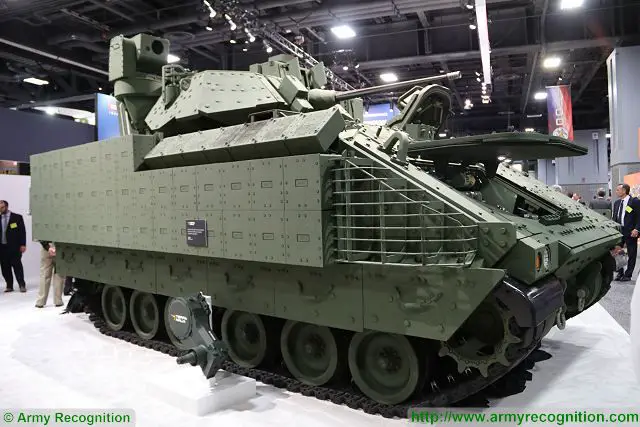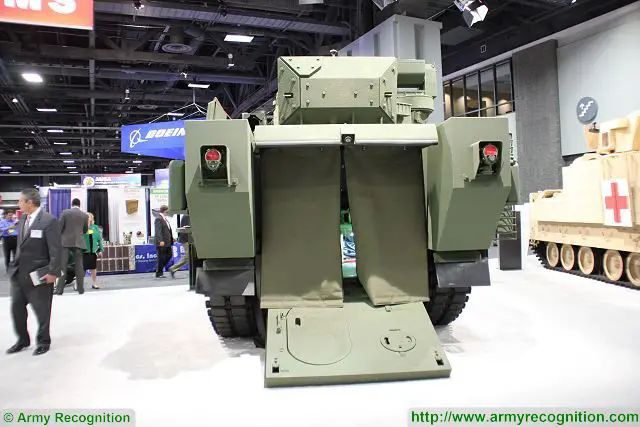BAE Systems Next Generation Bradley IFV Infantry Fighting Vehicle for United States Armed Forces 10612162
|
|
|||
|
Defense Industry Technology - Next Generation Bradley
|
|||
|
|
|||
| BAE Systems Next Generation Bradley IFV Infantry Fighting Vehicle for United States Armed Forces | |||
|
At AUSA 2016, the Association of the United States Annual Meeting & Exposition, BAE Systems has launched demonstrator of Next Generation Bradley Fighting Vehicle The concept vehicle features an upgraded chassis that allows for significantly increased underbelly protection, improved force protection for mounted troops, compartmentation of fuel and ordnance, and more space and electrical power for future technology growth.
|
|||
|
|
|||
 BAE Systems Bradley Next Generation at AUSA 2016, defense exhibition in Washington D.C., United States, October 5, 2016 BAE Systems Bradley Next Generation at AUSA 2016, defense exhibition in Washington D.C., United States, October 5, 2016 |
|||
|
|
|||
|
The goal of this project is to extend the live time of the current Bradley IFV used by the US Armed forces offering more protection and increase the mobility of the vehicle.
The Bradley demonstrator concept features an upgraded chassis that allows for significantly increased underbelly protection, improved force protection for mounted troops, compartmentation of fuel and ordnance, and more space and electrical power for future technology growth. “In the current budget environment, the Army often has to choose between maintaining an existing fleet and developing new capabilities,” said Deepak Bazaz, director of Artillery and Bradley Programs at BAE Systems. “We’re investing in research and development to demonstrate cost-effective options for the Army to address current gaps. We’re focused on integrating current, emerging, and future technologies to significantly improve the Bradley’s mobility, force protection, and lethality. The Next Generation Bradley includes suspension upgrades to enhance mobility to maneuver within the Armored Brigade Combat Team (ABCT). It incorporates an upgraded turret from the current Bradley and enhancements achieved during ongoing Engineering Change Proposal modernization efforts, such as suspension improvements, targeting sensors, and network connectivity. BAE Systems will use this vehicle to mature these technologies and provide a platform for development and user experimentation and evaluation. The prototype features armor, fuel tanks, and the driver’s hatch from the Armored Multi-Purpose Vehicle, and the 600 volt electronics and final drives from the M109A7 Self-Propelled Howitzer integrated with current and future Bradley systems. Leveraging technology from other BAE Systems-built vehicles in the ABCT allows for significant savings in both development time and cost. In addition, the commonality of parts among the vehicles also provides significant cost savings opportunities over the life cycle of the vehicle and reduces the complex logistics trail. |
|||
|
|
|||
 |
|||
|
|
|||
|
The next generation of Bradley BAE Systems will be fitted the latest-model of A4 Bradley turret with new electronic devices, armed with the M242 25 mm Bushmaster Chain Gun with a 7.62 mm M240C machine gun mounted coaxially to the right of the main armament.
Second armament also includes the twin tube TOW anti-tank guided missile launcher unit mounted to the left of the turret. The target is tracked using an optical sight, which detects the infrared signal from the back of the missile in flight. The range of the TOW missile is 3.75 km. The next generation Bradley will continue to be fitted with the Commander's Independent Viewer (CIV), available on the Bradley A3. It provides a 360-degree panoramic view of the battlefield to enhance situational awareness and weapon effectiveness. The hull of the new Bradley is redesigned to increase survivability of the vehicle and to offer more internal space for the troops. The floor is more protected against mine blast. The vehicle will be fitted with a combination of passive and active armour for improved survivability against blast threats. The new BAE Systems Bradley project will be motorized with a new more powerful engine, transmission and generator to offer same performance that the current Bradley IFV despite a 10 ton weight increase. At AUSA 2016, BAE Systems also displayed a mock up of Mitsubishi suspension called Terra Ninja. The Japanese Company Mitsubishi Heavy Industries has especially designed this new suspension for the U.S. Army's Bradley Fighting Vehicle. |
|||
|
|
|||
|
|
|||


























